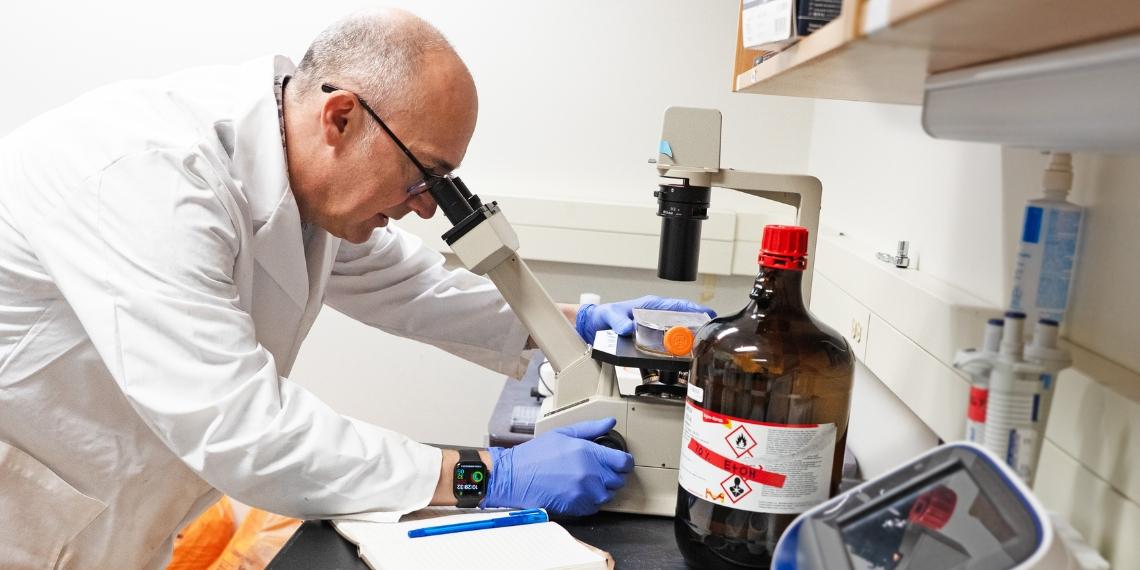One Gene, Two Fates: How a Single Mutation Spot Triggers Two Deadly Heart Diseases

Cardiovascular disease continues to affect millions globally, but scientists in the Department of Molecular and Cellular Biology are homing in on a crucial piece of the puzzle: how mutations in a single gene can lead to radically different, and deadly, heart conditions.
Dr. John Dawson and team have spent the past decade exploring the heart at its most fundamental level: the proteins that make it beat.
Their recent research focuses on actin, a key protein responsible for the contraction of heart muscle. Using highly specialized single-molecule assays and years of protein engineering work, they discovered something truly unexpected: two different mutations at the exact same spot in actin can lead to two completely opposite diseases, hypertrophic cardiomyopathy and dilated cardiomyopathy. The former is characterized by a thickening of the heart muscle, while the latter is marked by a thinning of the muscle. Both conditions impact the heart’s ability to pump blood.
“This surprised us,” Dawson admits. “We thought these different diseases would be caused by opposing molecular mechanisms. But both mutations caused the same molecular change, an increased sensitivity to calcium. So why do they produce opposite outcomes?”

Actin acts like a railway track for myosin, the motor protein that powers muscle contraction. When mutations occur in this “track,” they can derail how the heart functions. Dawson’s lab studied two clinically reported actin mutations at position 312 of the protein, R312H and R312C. Both mutations made the muscle hypersensitive to calcium, a key trigger for contraction. According to the prevailing theory, this should cause the heart muscles to become abnormally thick, or hypertrophic cardiomyopathy. But one of these mutations, R312C, was found in patients with dilated cardiomyopathy, where the heart becomes stretched and weak.
“It turns out the clinical trajectory of the disease matters,” Dawson explains. “Some patients with hypertrophic cardiomyopathy actually progress to a dilated form over time. The muscle over-contracts, degrades, and weakens, so the disease might start as one thing and end as another.”
This observation not only challenges earlier hypotheses but also highlights that the relationship between a mutation and its physical outcome is far more nuanced than previously believed.
 The research wasn’t easy. Dawson’s lab is one of the few in the world capable of producing human cardiac actin for research purposes. “It took about 10 years to develop our current systems,” he says. “The assays we use work at the level of individual molecules. They’re extremely precise, but also time-consuming and expensive.”
The research wasn’t easy. Dawson’s lab is one of the few in the world capable of producing human cardiac actin for research purposes. “It took about 10 years to develop our current systems,” he says. “The assays we use work at the level of individual molecules. They’re extremely precise, but also time-consuming and expensive.”
By building these protein models in a lab setting, Dawson’s team can now test virtually any actin mutation. Their hope is that by correlating specific mutation sites with specific disease outcomes, they can one day predict, and even prevent, disease progression in patients.
That’s where the promise of precision medicine comes in. Current heart disease medications often treat symptoms rather than the underlying causes, meaning the disease can continue to progress unnoticed. But if doctors can identify the exact molecular defect driving a patient’s cardiomyopathy, they could one day prescribe drugs that fix the protein malfunction itself, dramatically improving quality of life and life expectancy.
Dawson isn’t alone in this vision. His findings are contributing to an international database of genetic mutations related to heart disease. This shared resource allows researchers worldwide to identify patterns, compare results, and build predictive models. In time, this may allow doctors to determine the best treatment pathway based on a patient’s specific genetic makeup, an approach known as genotype-guided therapy.
“We’re still just scratching the surface,” says Dawson. “But every new mutation we study adds to our understanding. Eventually, we’ll have enough data to predict the outcome of a new mutation before it’s even seen in a patient. That could completely change how we treat heart disease.”

The lab’s next steps involve shifting from purified proteins to whole-organism models, such as transgenic zebrafish, which allow them to observe the physiological effects of mutations in a living system. If those findings align with their protein-level data, it will accelerate the development of new, more effective drugs.
This research underscores the value of basic science in tackling complex medical challenges. “To treat the disease effectively,” Dawson says, “we need to understand it at the molecular level. That’s where the future of medicine lies.”
For those affected by heart disease, or who carry genetic mutations but are still asymptomatic, this work offers hope. By decoding the subtle molecular missteps behind cardiomyopathies, scientists like Dawson are giving the heart its best shot at beating the odds.
This study was funded by the Heart and Stroke Foundation of Canada.
Read the full study in the Journal of Biological Chemistry.
Read about other CBS Research Highlights.